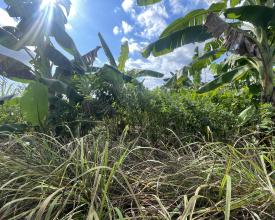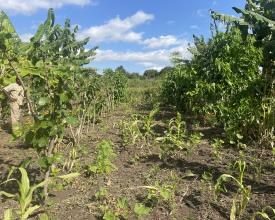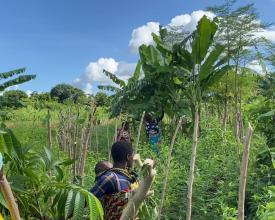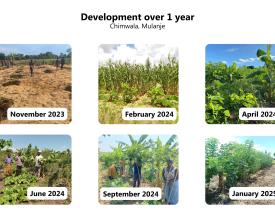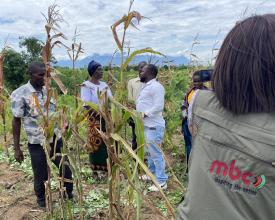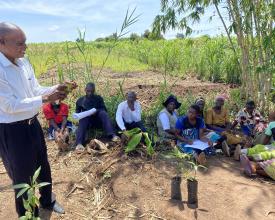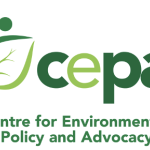
SYNTROPIC COMMUNITY FOOD FOREST FOR THE RESTORATION OF MALAWI'S NATURE AND PEOPLE
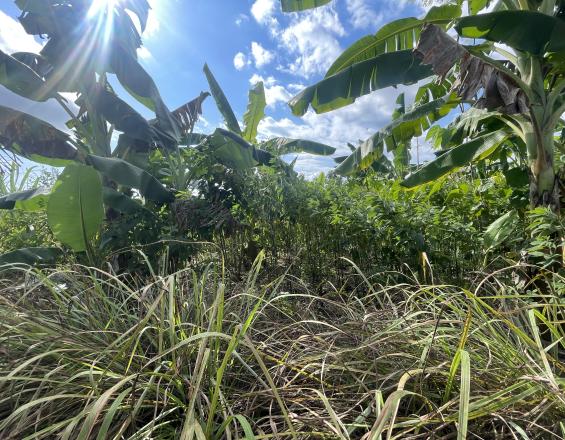
In response to deforestation and soil degradation, CARD and LUANAR launched a Syntropic Community Food Forest Demonstration Plot in Chimwala, Mulanje. Thedemo plot promotes sustainable agriculture by utilizing syntropic agroforestry, permaculture, and biofertilizer production techniques, which improve soil health and provide alternative income sources. Communities in Mulanje and Blantyre (Michiru Conserv Area) have successfully adopted these methods, generating income while restoring their land. This approach combines ecological restoration with economic opportunities, fostering local ownership and long-term conservation. Through training and participatory workshops, the initiative empowers communities, addressing environmental challenges while enhancing food security and resilience. This model highlights the importance of community engagement in sustainable land management and showcases the potential for local solutions to combat environmental degradation.
Context
Challenges addressed
• Some benefits are delayed: Although a syntropic planting design can bring in many plant species which complement and mutually support each other, the actual environmental benefits like restoration of soil fertility and reestablishment of rare species can take years depending on design, initial inputs and scale of the agroforestry system
-Positive changes in microclimate like increased and more stable rainfall, leading to higher water availability can be achieved through plots bigger than 500 ha
• Takes more time and effort to plant: the initial efforts to establish the agroforestry plot are quite high, as many seeds, mulching materials and labour are needed
• Need to learn new skills: the involed community members need to be mentored for a longer time to acquire needed skills like mixed planting, pruning and grafting (and permaculture).
• Mindset shift requires extra efforts on community- as well as on a regional and national political level
• Policy Change is challenging but ABSOLUTELY INDISPENSABLE in the long run
Location
Process
Summary of the process
Raising awareness and empower smallholder farming communities in Malawi is the basis for real change. If smallholder farmers understand that they are the main actors to create this change, the solutions proposed to them can unfold much deeper within their communal entities. The detachment of synthetic-chemical fertilizers and pesticides is another pillar for smallholder farmers to become food sovereign and climate resilient: promoting a diverse soil life with biological fertilizers and withdrawing from chemical agents will not only enhance the soil microbiome, but also human health and resilient, productive agroecosystems.
Building Blocks
Local and national awareness campaign on agroecology
Agroecology is a holistic approach, often described as a practice, a science and a social movement. Agroecology is the base for all interventions suggested in this solution.
As the initiated mindset change requires a fundamental, global behavioural change, an essential part of the efforts are directed to advocacy and awareness building activities such as information spreading through media houses, social media channels and conducting field visits with stakeholders from government, policy makers, educational entities, NGOs, donors and the private sector.
Malawi has a population of around 22 million (worldometer 2025), of which almost 18 million are smallhoder farmers. If the initiated grassroot movement can be strengthened, Malawi could act as a leader in the global agroecological movement.
Enabling factors
In times of climatic and economic crisis, smallholder farmers in Malawi are very vulnerable in terms of food security.
Microcredits for smallholder farmers who venture into (agricultural) businesses are more likely to transition to agroecology, as long as their basic needs are covered.
Lesson learned
It is fundamental to involve governmental agricultural extension officers, as they are long-term stakeholders who monitor and accompany the practical implementers in the field, the smallholder farmers.
To accelerate this process, strong advocacy efforts are needed on national level that push for policy shifts and their implementation.
Biofertilizer and biopesticde production for restoration of natural soil fertility
27 farmers benefitted directly from learning how to prepare their own biofertilizers and biopesticides with locally available ingredients. The goal is to gradually reduce mineral fertilizers and chemical pesticides until it they are completely quitted.
Lesson learned
If participating smallholder farmers are supported with materials to prepare their own biological amendments and are guided in the production and application, they are more likely to prepare these themselves and more likely to quit chemical-synthetical prodcuts.
Local, regional and national advocacy meausres are required to build awareness among all stakeholders.
Impacts
The initiation of a mindset change for participating smallholder farmers, agricultural extension officers, politicians, and other stakeholders such as representatives from CSOs, educational entities, and the private sector has been the main goal and one of the biggest impacts of the project.
"When the project was starting, I thought it was impractical to mix trees and crops on such a small piece of land. However, reaching this far, I have learned to see the value of this unique type of setup in the long term." (Farmer and participant in the project).
8 out of the 20 actively participating farmers have immediately started small trials on their own field, experimenting with different perennial and annual species, and also prepared their own biofertilizers.
Over 250 stakeholders have visited the demo site during trainings, conferences, and visits, contributing to a discussion on how to wider apply Syntropic Agroforestry and regenerative farming techniques and their potential in Malawi and the region. Many participants and stakeholders increasingly question current national policies.
The planting of over 60 species on a small space led to a tremendous increase in local biodiversity. Indigenous timber trees and grasses planted alongside the river demonstrated to prevent erosion during extreme rainfall events. Many of the established plant species were propagated and planted on other farmers' fields.
Beneficiaries
More than 20 farmers benefitted from 6 practical sessions in regenerative farming techniques and received equipment to start their own plot. 110 family members were reached out to.
Around 250 stakeholders from different sectors visited and learnt from the site.
Global Biodiversity Framework (GBF)
Sustainable Development Goals
Story
Story / Documentary narrated by smallholder farmer community and extension officers in Chimwala can be viewed on Youtube:
- November 2023 (Mzati TV): https://www.youtube.com/watch?v=6w3GEvtWs6M&t=3s
- April 2024 (MBC): https://www.youtube.com/watch?v=kA2abOkrL9A&t=233s
- September 2024 (MBC): https://www.youtube.com/watch?v=9dx2o6KkW2o&t=53s
- September 2024 (Mzati TV): https://www.youtube.com/watch?v=231_AJS6Z7Y&t=117s

